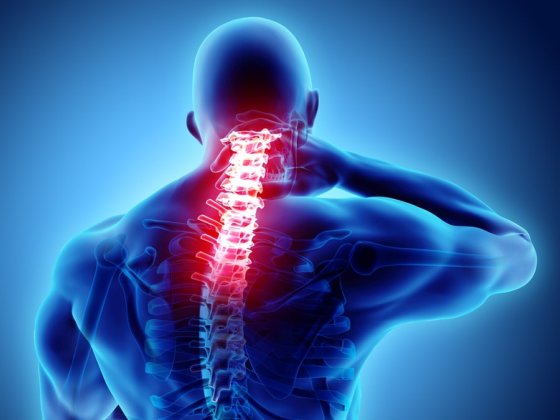
Rear-end collisions can cause significant back and neck injuries. We’ve all heard of whiplash, a common injury in these types of accidents which can be very painful and debilitating. But whiplash only constitutes one of a range of significant back and neck trauma that can result from being rear-ended. In this article, we describe how rear-end collisions cause injuries and the challenges victims of these accidents can face in the days, months, and even years that follow.
How a Rear-End Collision Causes Injuries
In a rear-end collision, the lead car jolts forward. Its occupants often have little warning before the impact. The force of the collision pushes them backward into their seats initially, and then forward as they rebound, as depicted in this Insurance Institute for Highway Safety video. Vehicle occupants wearing seatbelts remain restrained in their seats, but their head, neck, and upper back often pitch forward violently.
The spine and the muscles and tendons that surround it and support the head and neck don’t usually handle this rapid movement well. At a minimum, whiplash (damage to the muscle and soft tissue in the neck and upper back) is common. But a violent blow to the vertebral column such as the type inflicted in a rear-end collision can also cause more significant damage to the vertebral structures, resulting in damaged disks and, potentially worse, spinal cord injury that affects the brain’s ability to communicate with the body.
While the severity of these injuries will vary based on the force of the accident, the vehicles involved, and the victims’ preexisting health condition, back and neck injuries (including spinal cord injury) can feature the following symptoms:
- Pain (often chronic)
- Loss of sensation or loss of movement
- Breathing difficulties
- Partial or total paralysis
- Muscle spasms or tightness
- Difficulty swallowing or chewing
- Burning or tingling sensations
Some of these symptoms may resolve in time, but others may be permanent, particularly in the case of spinal cord injuries that cause paralysis. In addition, because these injuries tend to limit a person’s mobility and life function, they can lead to a wide range of secondary health complications associated with not being able to move, exercise, and otherwise stay healthy.
The Cost of Back and Neck Injuries
Any injury, even a minor one, comes with costs. Victims of rear-end collisions often spend money on pain medications, physical therapy, massages, and other therapeutic treatments to help them deal with the chronic pain of a back or neck injury. These expenses can vary widely, but they’re always unwelcome.
More severe back and neck injuries may require surgery to repair slipped or damaged disks. Victims may also have to spend money on assistive devices and modifications to their living space to make it easier to get around while recovering from or living with a bad back. These costs can run into the tens, if not hundreds, of thousands of dollars, even when the victim has insurance.
Finally, when a rear end collision leaves a victim paralyzed from a spinal cord injury, the costs can be massive. The Christopher & Dana Reeve Foundation estimates that the minimum cost of dealing with a spinal cord injury that results in any kind of motor deficit will run to $350,000 in the first year and could easily reach as high as $1 million in the case of more severe paralysis. Over a lifetime, those costs soar even further, covering expenses such as:
- Medical treatment
- Surgeries
- Durable medical equipment, including wheelchairs, braces, walkers, and mobility aids
- Alterations to a home to make it wheelchair accessible
- Alterations to a vehicle to make it accessible
- The cost of around-the-clock care if necessary
Additionally, many victims of rear-end collisions can’t return to work after their accidents, or may return to work in a different capacity after the accident. Time at work may be limited or job responsibilities changed, leading to significantly decreased income.
Pursuing Compensation After a Neck or Back Injury From a Rear-End Collision
Because of the high cost of living with neck or back injuries after a rear-end collision, many victims take legal action to pursue compensation from those responsible for causing the accident. Most often, the driver in the rear vehicle will bear at least some responsibility for a rear-end collision. Other parties who may have liability to a victim of a rear-end collision may include the employer of a commercial vehicle that rear ended the victim’s car, vehicle manufacturers, and even local and state governments responsible for maintaining safe roadways.
The compensation a victim may recover after a rear-end collision causes back and neck injuries often covers:
- Medical expenses. Medical bills add up fast, even when a victim with a back or neck injury has insurance. The cost of ongoing care for a victim, such as medications for chronic pain, the cost of recovering from multiple surgeries, and medical/assistive devices, may all be recoverable in a legal action for damages after a rear-end collision.
- Payment for pain and suffering. Chronic pain is often a central feature of living with a neck or back injury. Pain itself can be so debilitating that it limits the rest of the victim’s life. The damages a victim may recover often seek to compensate them for that suffering.
- Lost wages and lost earning capacity. When you live with a spinal cord injury, your work prospects may change drastically. You may no longer have the capacity to work in a job that requires manual labor or to sit for long periods of time behind a desk. In many cases, you may have to miss work for a long period of time after the accident while you heal. Damages for a back and neck injury may therefore include reimbursement for lost wages and funds to make up for a loss of your ability to earn a living in the future.
Do You Need Legal Help After a Rear-End Collision?
Victims of rear-end accident dealing with severe pain and disability from a back or neck injury often don’t know where to turn for help managing the unexpected financial burdens they face. Working with an experienced personal injury lawyer will often give them the best chance of recovering the compensation they deserve. A skilled attorney can take over negotiations with insurance companies, investigate the accident, and take legal action, while the victim focuses on recuperating.
If you sustained a back or neck injury in a rear-end collision in the New York City area, don’t wait to seek knowledgeable legal representation. Contact Ivan Diamond Bronx Personal Injury Attorney today at (718) 588-2000 to schedule a free consultation and learn about your rights.



